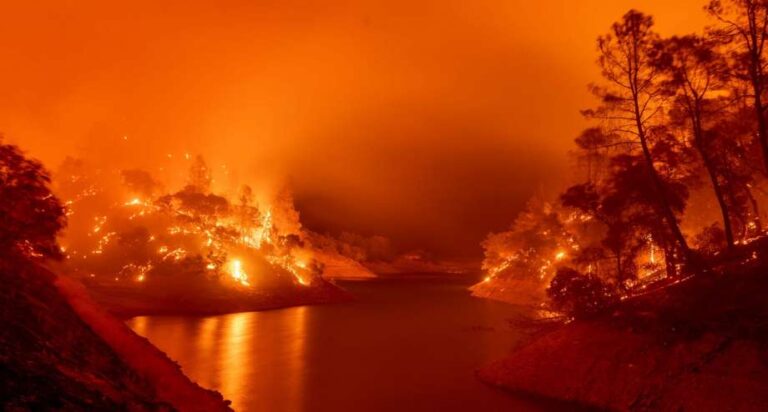
(AP)- Justin Silvera came off the fire lines in Northern California after a grueling 36 straight days battling wildfires and evacuating residents ahead of the flames. Before that, he and his crew had worked for 20 days, followed by a three-day break.
Silvera, a 43-year-old battalion chief with Cal Fire, California’s state firefighting agency, said he’s lost track of the blazes he’s fought this year. He and his crew have sometimes been on duty for 64 hours at a stretch, their only rest coming in 20-minute catnaps.
“I’ve been at this 23 years, and by far this is the worst I’ve seen,” Silvera said before bunking down at a motel for 24 hours. After working in Santa Cruz County, his next assignment was to head north to attack wildfires near the Oregon border.His exhaustion reflects the situation on the West Coast fire lines: This year’s blazes have taxed the human, mechanical and financial resources of the nation’s wildfire-fighting forces to an extraordinary degree. And half of the fire season is yet to come. Heat, drought and a strategic decision to attack the flames early combined with the coronavirus to put a historically heavy burden on fire teams.
“There’s never enough resources,” said Silvera, one of nearly 17,000 firefighters battling the California blazes. “Typically with Cal Fire, we’re able to attack — air tankers, choppers, dozers. We’re good at doing that. But these conditions in the field, the drought, the wind, this stuff is just taking off. We can’t contain one before another erupts.”
Washington State Forester George Geissler says there are hundreds of unfulfilled requests for help throughout the West. Agencies are constantly seeking firefighters, aircraft, engines and support personnel.
Fire crews have been summoned from at least nine states and other countries, including Canada and Israel. Hundreds of agreements for agencies to offer mutual assistance have been maxed out at the federal, state and local levels, he said.
“We know that there’s really nothing left in the bucket,” Geissler said. “Our sister agencies to the south in California and Oregon are really struggling.”
Demand for firefighting resources has been high since mid-August, when fire officials bumped the national preparedness level to critical, meaning at least 80% of crews were already committed to fighting fires, and there were few personnel and little equipment to spare.
Because of the extreme fire behavior, “you can’t say for sure having more resources would make a difference,” said Carrie Bilbao, a spokesperson for the National Interagency Fire Center. Officials at the U.S. government operation in Boise, Idaho help decide which fires get priority when equipment and firefighters run scarce nationwide.
Government spending on fighting wildfires has more than tripled since the 1990s, to an average of $1.8 billion annually. That’s failed to reduce the problem as climate change, drought and millions of trees killed by pests led to more fires in the Western U.S. over the same period, particularly dangerous “megafires” that burn 100,000 acres (404 square kilometers) or more.
The growing severity has spurred federal lawmakers to push prevention efforts, including controlled burns, faster approval of logging projects and upgrading homes to make them more fire resistant.
“We are at a critical time: The West is burning. People are dying. The smoke is literally starting to cover our country, and our way of life as we know it is in danger,” Republican U.S. Sen. Steve Daines of Montana said Wednesday during testimony in support of an emergency wildfire bill, co-sponsored by Democratic Sen. Dianne Feinstein of California, that would direct more resources to prevention.
Andy Stahl, a forester who runs Forest Service Employees for Environmental Ethics, an advocacy group in Oregon, said it would have been impossible to stop some of the most destructive blazes, a task he compared to “dropping a bucket of water on an atomic bomb.”
Yet Stahl contends the damage could have been less if government agencies were not so keen to put out every blaze. Extinguishing smaller fires and those that ignite during wetter months allows fuel to build up, setting the stage for bigger fires during times of drought and hot, windy weather, he said.
That’s been exacerbated this year by the pandemic, which led U.S. Forest Service Chief Vicki Christiansen to issue a directive in June to fight all fires aggressively, reversing a decadeslong trend of allowing some to burn. The idea was to minimize large concentrations of firefighters by extinguishing blazes quickly.
Fighting the flames from the air was key to the strategy, with 35 air tankers and 200 helicopters used, Forest Service spokesperson Kaari Carpenter said.
Yet by Aug. 30, following the deaths of firefighters, including four aviators, fire officials in Boise warned that long-term fatigue was setting in. They called for a “tactical pause” to reinforce safe practices.






